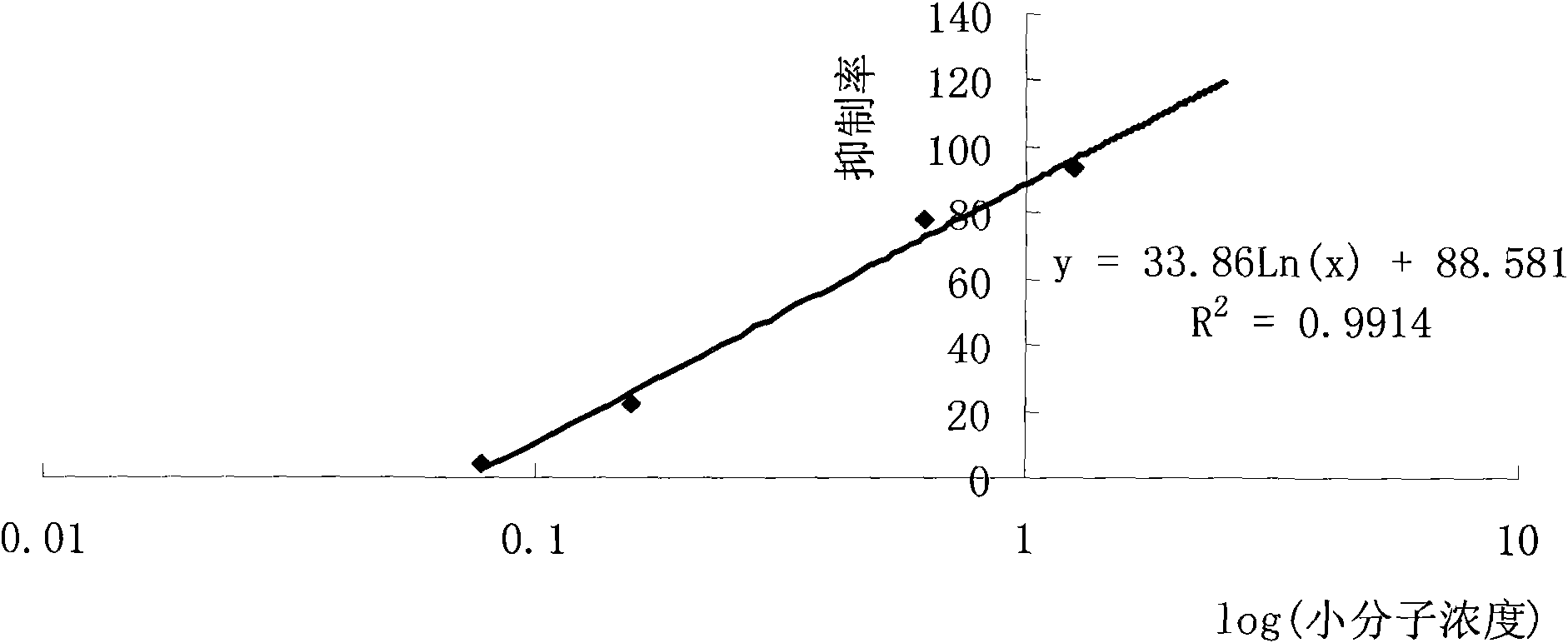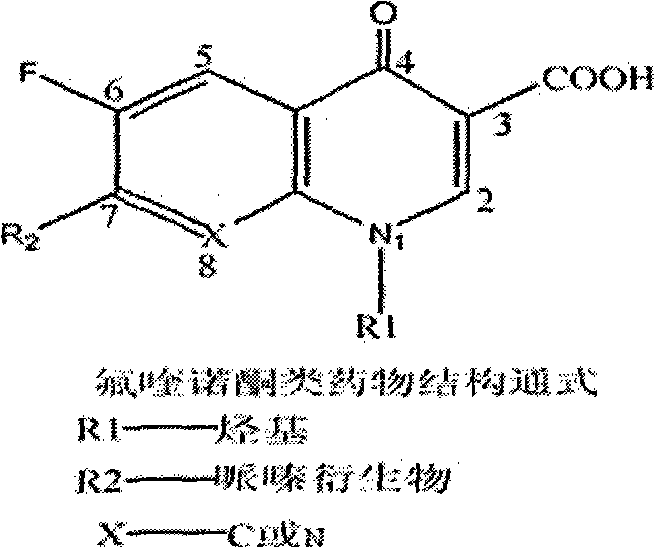Preparation method of anti-fluoroquinolone rabbit monoclonal antibody and application thereof
A monoclonal antibody, anti-fluoroquinolone technology, applied in the field of immunochemistry, can solve problems such as harm to human health, unfavorable development of livestock and poultry products, drug residues, etc., and achieve high-broad-spectrum effects
- Summary
- Abstract
- Description
- Claims
- Application Information
AI Technical Summary
Problems solved by technology
Method used
Image
Examples
Embodiment 1
[0038] Example 1 Synthesis of Immunization Antigen and Coating Antigen
[0039] The following six fluoroquinolone drugs were selected for immunoantigen synthesis to be coupled to the carrier protein bovine serum albumin: ofloxacin, dafloxacin, ciprofloxacin, norfloxacin, enrofloxacin, flumequine . The six drug structures are as follows:
[0040]
[0041] 1) Dissolve 30 mg of ciprofloxacin, 45 mg of N-hydroxysuccinimide and 150 mg of carbodiimide hydrochloride in 1.5 mL of dimethylformamide, and stir for 24 hours in the dark to obtain a ciprofloxacin reaction solution; 100 mg of bovine serum albumin was dissolved in 15 mL of phosphate buffer to obtain a bovine serum albumin solution, and the ciprofloxacin reaction liquid was added dropwise to the bovine serum albumin solution, stirred for 3 hours, and dialyzed with phosphate buffer. Obtain ciprofloxacin immune antigen, and store at -20°C; ofloxacin immune antigen, enrofloxacin immune antigen and ciprofloxacin immune antige...
Embodiment 2
[0047] Example 2 Fluoroquinolone rabbit monoclonal antibodies produced
[0048] 2.1 Immunization of rabbits
[0049] The six immune antigens synthesized above were mixed and immunized into rabbits by subcutaneous injection on the back, and 2ml of blood was collected before immunization. For the first immunization, 0.5 mg of each of the six immune antigens was mixed with an equal amount of Freund's complete adjuvant for immunization, and the second was immunized. From the second to the fifth immunization, 0.25 mg of each of the six immunization antigens was mixed with an equal amount of Freund’s incomplete adjuvant for immunization, and the immunization interval was two weeks, and the booster immunization was arranged within 4-8 weeks after the fifth immunization. Mix 0.5 mg of each of the six immune antigens and inject intravenously, kill the rabbit 4 days after the injection, and take the spleen for later use;
[0050] 2.2 Cell Fusion
[0051] Spleen is aseptically taken, a...
Embodiment 3
[0056] Indirect ELISA and direct ELISA operating steps in the screening process of embodiment 3
[0057] 3.1 The steps of indirect ELISA method are as follows:
[0058] 1. Coating plate: Dilute the six coating antigens to 0.5 μg / mL with coating buffer (CBS) and mix the coating plate, 50 μl / well, coat overnight at 4°C or coat at 37°C for 2 hours;
[0059]2. Plate washing: wash once with TBST, 200μl / well;
[0060] 3. Blocking: 0.2% gelatin / TBS, 100 μl / well, 37°C for 1 hour;
[0061] 4. Plate washing: wash three times with TBST, 200 μl / well;
[0062] 5. Adding samples: 50 μl / well of the supernatant stock solution or diluted solution of each cell culture well, reacting on a shaker at 30°C for 1 hour;
[0063] 6. Plate washing: wash the plate three times with TBST, 200 μl / well;
[0064] 7. Secondary antibody: add 2500-fold diluted alkaline phosphatase-labeled goat anti-rabbit, 50 μl / well, and place on a constant temperature shaker at 30°C for 40 minutes;
[0065] 8. Plate wash...
PUM
| Property | Measurement | Unit |
|---|---|---|
| Half inhibitory rate | aaaaa | aaaaa |
Abstract
Description
Claims
Application Information
 Login to View More
Login to View More - R&D
- Intellectual Property
- Life Sciences
- Materials
- Tech Scout
- Unparalleled Data Quality
- Higher Quality Content
- 60% Fewer Hallucinations
Browse by: Latest US Patents, China's latest patents, Technical Efficacy Thesaurus, Application Domain, Technology Topic, Popular Technical Reports.
© 2025 PatSnap. All rights reserved.Legal|Privacy policy|Modern Slavery Act Transparency Statement|Sitemap|About US| Contact US: help@patsnap.com



